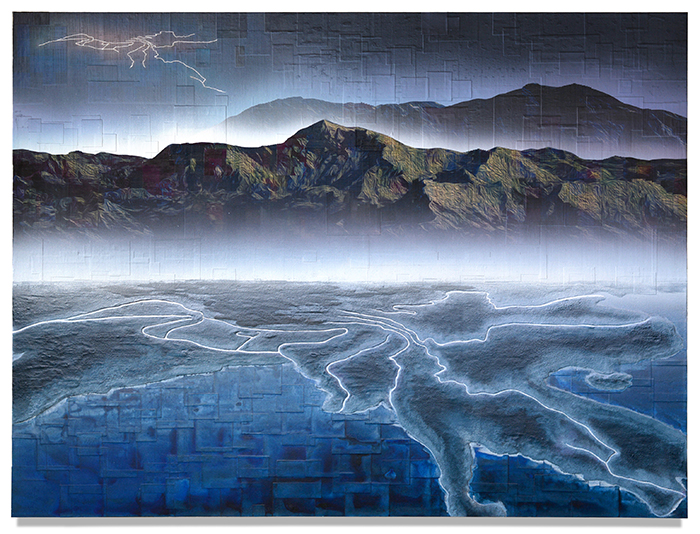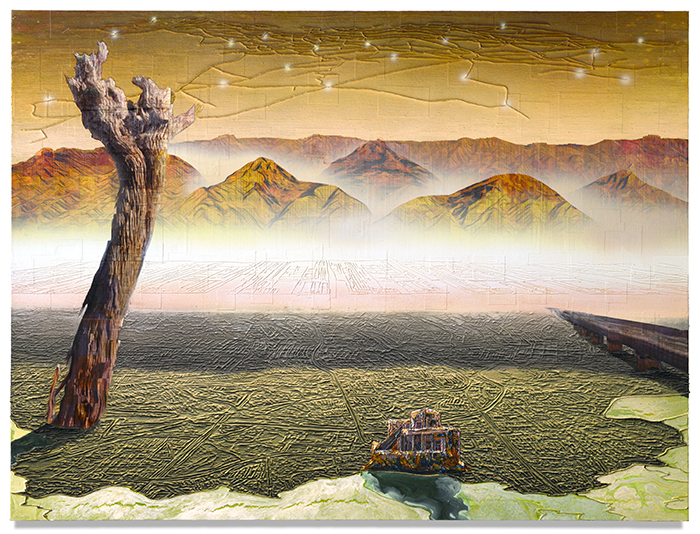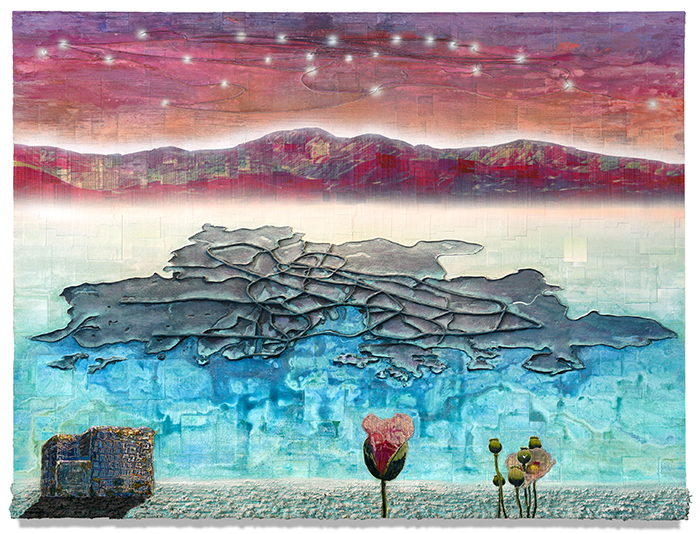Mark Rappolt talks to the British artist about landscape, infrastructure and mythologies
British artist Gordon Cheung’s paintings and sculptures dissect the imagery of a globalised world. Drawing on disparate landscape traditions, as well as financial and digital infrastructure, his work maps out our contemporary dystopia. ArtReview Asia caught up with him amid his exhibition in London, Tears of Paradise.
ArtReview Asia I’d like to start with how your paintings are created – and talk about perversion. There’s a perverse way that you take the newspaper data of markets and stocks, which is the background for the paintings, and then you overlay it with quasi-romantic, idealised landscape imagery, and then further superimpose the data of structural networks in Greater China on top. How do those two things, the slightly romantic portrayal and this data analysis, fit together?
Gordon Cheung We perceive the world through mythologies and stories – fictional realities. These stories bind us and help unite us in order to be able to then pursue bigger projects. The biggest projects are civilisations. From 1995 I started using the stock listings in the Financial Times to reference this information space that we found ourselves in, a digital and communications revolution. I felt that this was our new landscape, and I found it profoundly compelling to try to find a way to visualise.
ARA In these recent works, which tackle Greater China, or Hong Kong and China – depending where you sit – there’s also a relationship to the colonial history of Hong Kong that is very much about numbers and profits, and has a particular resonance in these works.
GC When the handover happened in 1997, I immediately made a piece of work responding to it. I was in the living room of my flat and I grabbed hold of these lychee cans and started shredding them, because they depicted these arcadian landscapes of China with the beautiful image of a factory pumping out smoke. I liked the disparity between those two images. Hong Kong was something back then that I didn’t really understand – even though my parents are from there – as being a colony, with all this imagery of the handover and the importance that was given to it going back to China. It probably took another 15 years before I started to realise some of the histories behind that event, and that’s what I started looking at more in this recent body of work.
ARA You were talking earlier about how stories are what unites us. Were I a representative of the Chinese government, I might say that it’s infrastructure and railway systems and communication systems that have united us. Maybe you could describe the systems that you’ve mapped out in these paintings.
GC The exhibition in London begins with two paintings that offer the widest perspective. Towers of Water [all works 2020] depicts the Himalayan Mountains, referred to as the ‘Water Towers of Asia’, the Tibetan plateau and the main river systems in China that are beginning to be dammed up. It’s to supply hydroelectricity demands, but there are those who rely on the river downstream that China will then have political leverage over. The other painting, String of Pearls, is actually a term that was devised by a US military consultant to suggest that China’s infra-structural investment in these ports along the Maritime Silk Road is for offence and defence purposes. Obviously, China denies that and says that it’s to do with connecting trade routes and maintaining or strengthening relations between the nations in which they’re investing.
Looking at the series of paintings, you get progressively closer to China’s infrastructure projects. For example, the title painting of the show, Tears of Paradise, depicts the Pearl River economic zone, nine districts of 22 million people who are connected by high-speed rail and worth about 20 percent of China’s GDP. Along the top of the painting is a map of the Belt and Road Initiative, which are the nations being connected by China’s trade agreements. It’s the largest project in human history.

ARA These infrastructure developments also seem to involve curious extensions of Chinese legal dominions, in the sense that a lot of the laws that govern these developments are Chinese law, even if they happen to be, say, in the Pacific Islands. Do you think these structures are shifting the global geopolitics as much as the local ones?
GC China was the manufacturing hub of the world, and now that their middle classes are growing, there’s a shift towards creating an internal economy. The resources that they need can no longer be solely found within China itself, so they have to extend beyond, and seem to be enacting policies that are more about strengthening mutual trade between nations. Rather than going in and invading or demanding, they’ve decided to work with other nations, which has different repercussions.
ARA Which is in some ways very similar to, say, the East India Company.
GC The East India Trade Company is actually featured in String of Pearls: a boat in the bot- tom corner of the painting is the British gun-boat Nemesis, which was the first to go to China. During what was to be called the Opium Wars, the East India Trade Company was smuggling opium into China in exchange for silver, which eventually led to Hong Kong being colonised by the British.
ARA In a lot of the works, you’ve pictured these infra- structure systems as constellations – mythologised them.
GC Yes, they’re written in the stars as if they refer to a sort of destiny. The paintings are a kind of a convergence of real structures, but then these real structures are also surrounded by mythologies. In order to be able to sell these sorts of projects to people to get them to build them, it has to be for a greater ‘good’, and that’s often wrapped up in ideas of becoming ‘greater’. In each of the paintings there’s also a sacred mountain, and these sacred mountains – a set of five – were traditionally sites than an emperor would visit in order to sanctify his divine rights to rule over his subjects. I was layering different fictional realities on top of each other. In general, although not in all of the paintings, there’s a human scale at the bottom, then a harnessing of the landscape through the middle, and then a sort of divine order or fictional reality, and then a future space at the top.
ARA What is the architecture that you’re depicting at this human scale?
GC The buildings or the animals at the bottom are the symbol of the home, the basic unit of a civilisation, and these aren’t any old buildings. For example, in Desert of the Real, the building is one in Kashgar that was demolished. The area depicted in that painting is the Xinjiang province, in Northwest China, where the Uyghur Muslims are being ‘reeducated’ – in what many in the West call ‘concentration camps’. It’s a particularly sensitive subject. Beyond the human-rights issues and the questions of how a civilisation or leadership deals with certain minorities, that area is going to be the busiest intersection of the Belt and Road project – it borders eight nations.
One of those nations has invaded China in the past: Russia. At that time, in 1949, the USSR supported the separatist movement of the Uyghur Muslims in that region. They then abandoned them for favourable terms with China. The high-speed rail that runs through the region is what features across the top of the painting, and what enabled a form of internal colonisation; where the demographics of that region were once around 80 percent Uyghur, it has become 45 percent Uyghur and about 40 percent Han Chinese.
ARA It’s interesting, coming back to statistics and facts, in how they inform the landscapes and constellations to become mythologising and maybe ‘un-datafiable’ characteristics in the works. There’s a sense similar to the structure of science-fiction narratives, trying to fix this point that’s tied to a present reality but obstructed from it at the same time. It also speaks a little bit to the fiction that emerged, for instance, after Tiananmen Square. Some of the fiction about it written from the side of the students would use things like The Classic of Mountains and Seas, an abstraction of reality, in order to tell their story.
GC All art in some ways has a political aspect to it, whether it’s apathy or acting overtly in creating a forum to think about some of those wider important issues. Even classic Chinese ink painting, for example; those painters were often the educated elite who worked for the emperor. The mountains represented the state and culture of the time, and they would use ink painting as a way of recording or codifying their relationship to the state, and how they felt that particular dynasty was in control.
ARA You use a multicoded language in your work that is hyperlinked in a way – the mountains the people may or may not recognise, the constellations that people probably do not recognise now but might impact on their lives sometime in the future. Your paintings, in the way you construct the images with a newspaper, also have this slightly pixilated aspect.
GC That goes back to the notion of mapping an information space that we all exist in. A world in which trillions of capital is able to move instantaneously and, wherever it accumulates, create dystopias and utopias. So the pixel is the unit, if you like, of that space. It’s the atom of that datascape, something that we’re extremely familiar with when we see low-resolution jpeg images and so on, so for me it is this artificial information space, and a pixel represents that. The works are an interface, like a screen, and how so much of our time is engaged through the screen to teleport through these electronic spaces.
ARA In these recent works, there’s nothing human.
GC There isn’t. I wanted to create an existential sort of space, and so when you remove the human, you yourself are the one who remains as you look into these spaces. At the brink of something epic and sublime are these questions of, ‘What does it mean to be? Who am I? Why am I?’ Despite the grandeur of these projects, or the enormity of what is one of the largest human projects in history, these questions persist. What do they ultimately mean?

ARA Are these same questions at stake for you in the sculptural hanging works that feature in the show?
GC As the paintings shift from a wider perspective towards more internal China projects, you reach this installation of traditional Chinese windows that for me represent a ghost architecture of homes phasing in and out. They were made in response to the rapid urbanisation of China, where many older buildings with these types of windows were torn down. The windows started to represent, for me, a conceptual demarcation between communism and capitalist communism. Of course, there are a lot of romantic narratives around windows – interiors and exteriors, wistfully looking out – so it had all these type of resonances that I was interested in.
All of the window designs came from a book that I found in a thriftshop in London’s Chinatown about 15 years ago. Some of these can look as though they come from Islamic or even Greek traditions. The scholars on the designs of Chinese traditional windows are very few, but I think it’s probably to do with the transmission of culture, through the Silk Roads, which were basically globalisation at the pace of a camel.
ARA That’s an interesting reflection in respect to the paintings too, that diffusion of different cultural references. Any one painting might be simultaneously drawn from an eighteenth-century, classical Western landscape, as much as it might also reference a traditional Chinese classical landscape. Does this also relate to the history of landscape, in either tradition, being about ownership, whether it’s physical property or intellectual property?
GC I’ve always been interested in the tradition of the sublime landscape painting. But they would’ve had people in them, a tiny figure in them that would represent a conqueror. Often those territories are magnificent virgin worlds, promised lands that the tiny figure has discovered, and so they erased the indigenous people who were there, both from the narrative of the landscape and in reality. I was always fascinated by the romantic language of it. It would be the force and awe of nature overwhelming the individual, a kind of terror. That experience was what brought you close to the experience of God. God was in the force of nature, the beauty and the sheer overwhelming scale.
ARA Does that mean that in these recent paintings the infrastructures at work are the gods?
GC I used to think about the stock market in that way – as a new god. What is omniscient, omnipotent? It’s these numbers that affect all of us, and no more sensationally and spectacularly evidenced than by the 2008 financial crisis. There was truly a period where we didn’t know whether the system itself was going to survive, or whether it was going to completely collapse into an apocalypse of sorts. It was this crazy time when ‘the end of capitalism’ was frontpage news. Obviously it carried on, but it’s the idea that these numbers are constantly surrounding us, perhaps in the same way in which divine narratives are constructed.
ARA The hanging window-frame works are also made up of the stock listings from the newspaper, numbers that construct the geometries of the frames. Is one way of seeing them just as a mathematical pattern?
GC The numbers on the stocklistings represent the dominant economic model on a global scale. It was, at the start, a convenient material to use. I was literally using it like a pigment for paintings, pulping to make my own version of the paint, but that paint was actually information of the very space that I was trying to depict in the work. Now it’s data that no serious trader would use, this information is redundant. It seems part of tradition, just as much as eighteenth-century landscape painting is. Now the primary use of the stock listing pages in the newspaper is as advertising space. I still think it has this relationship to that information space, and that’s the reason why I still continue to use this material.
In making the paintings or the sculptures, the core concerns, and the way that I think about constructing things, are similar. You just exchange different materials. I usually draw out a mind map, and then I’m able to piece out certain conglomerates of interconnected ideas and find the visual formats for each of those and layer them together. Both began from my interest in looking at the history of China, which became that much more important to me over the years. Understanding the contradictions and coming to terms with being born in the UK, living here in the UK, not understanding what the handover meant in 1997 and what it means to be a colonial subject who was born in a different country, as well as having the passport of the coloniser.
ARA Are the Tears of Paradise that gives the show its title a negative or positive thing?
GC As soon as you frame a work of art within a political forum, it becomes a very divisive issue. My aim is to lay down the facts and then leave it open to discussion. I don’t think in England or Britain they know that much about the Opium Wars, or what the Empire actually really did to the world that they colonised. These are extraordinary stories and incredible systems of organisation, achieved at a great human cost. Tears of Paradise is an ambiguous term. Whose paradise is it, and whose was it before? Who is crying over it, in joy or sadness, and who’s tearing it apart? These are some of the long-rooted historical questions that I’m interested in not only learning about but figuring out, and asking whether this is what we want our humanity to actually represent.
Gordon Cheung: Tears of Paradise was on view at Edel Assanti, London, January – March 2020
From the Spring 2020 issue of ArtReview Asia
